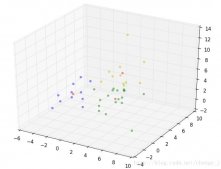DataLoader完整的參數表如下:
|
1
2
3
4
5
6
7
8
9
10
11
12
|
class torch.utils.data.DataLoader( dataset, batch_size=1, shuffle=False, sampler=None, batch_sampler=None, num_workers=0, collate_fn=<function default_collate>, pin_memory=False, drop_last=False, timeout=0, worker_init_fn=None) |
DataLoader在數據集上提供單進程或多進程的迭代器
幾個關鍵的參數意思:
- shuffle:設置為True的時候,每個世代都會打亂數據集
- collate_fn:如何取樣本的,我們可以定義自己的函數來準確地實現想要的功能
- drop_last:告訴如何處理數據集長度除于batch_size余下的數據。True就拋棄,否則保留
一個測試的例子
|
1
2
3
4
5
6
7
8
9
10
11
12
13
14
15
16
17
18
19
20
21
22
23
24
25
26
|
import torchimport torch.utils.data as Dataimport numpy as nptest = np.array([0,1,2,3,4,5,6,7,8,9,10,11])inputing = torch.tensor(np.array([test[i:i + 3] for i in range(10)]))target = torch.tensor(np.array([test[i:i + 1] for i in range(10)]))torch_dataset = Data.TensorDataset(inputing,target)batch = 3loader = Data.DataLoader( dataset=torch_dataset, batch_size=batch, # 批大小 # 若dataset中的樣本數不能被batch_size整除的話,最后剩余多少就使用多少 collate_fn=lambda x:( torch.cat( [x[i][j].unsqueeze(0) for i in range(len(x))], 0 ).unsqueeze(0) for j in range(len(x[0])) ) )for (i,j) in loader: print(i) print(j) |
輸出結果:
|
1
2
3
4
5
6
7
8
9
10
11
12
13
14
15
16
17
18
19
20
|
tensor([[[ 0, 1, 2], [ 1, 2, 3], [ 2, 3, 4]]], dtype=torch.int32)tensor([[[ 0], [ 1], [ 2]]], dtype=torch.int32)tensor([[[ 3, 4, 5], [ 4, 5, 6], [ 5, 6, 7]]], dtype=torch.int32)tensor([[[ 3], [ 4], [ 5]]], dtype=torch.int32)tensor([[[ 6, 7, 8], [ 7, 8, 9], [ 8, 9, 10]]], dtype=torch.int32)tensor([[[ 6], [ 7], [ 8]]], dtype=torch.int32)tensor([[[ 9, 10, 11]]], dtype=torch.int32)tensor([[[ 9]]], dtype=torch.int32) |
如果不要collate_fn的值,輸出變成
|
1
2
3
4
5
6
7
8
9
10
11
12
13
14
15
16
17
18
19
20
|
tensor([[ 0, 1, 2], [ 1, 2, 3], [ 2, 3, 4]], dtype=torch.int32)tensor([[ 0], [ 1], [ 2]], dtype=torch.int32)tensor([[ 3, 4, 5], [ 4, 5, 6], [ 5, 6, 7]], dtype=torch.int32)tensor([[ 3], [ 4], [ 5]], dtype=torch.int32)tensor([[ 6, 7, 8], [ 7, 8, 9], [ 8, 9, 10]], dtype=torch.int32)tensor([[ 6], [ 7], [ 8]], dtype=torch.int32)tensor([[ 9, 10, 11]], dtype=torch.int32)tensor([[ 9]], dtype=torch.int32) |
所以collate_fn就是使結果多一維。
看看collate_fn的值是什么意思。我們把它改為如下
|
1
|
collate_fn=lambda x:x |
并輸出
|
1
2
|
for i in loader: print(i) |
得到結果
|
1
2
3
4
|
[(tensor([ 0, 1, 2], dtype=torch.int32), tensor([ 0], dtype=torch.int32)), (tensor([ 1, 2, 3], dtype=torch.int32), tensor([ 1], dtype=torch.int32)), (tensor([ 2, 3, 4], dtype=torch.int32), tensor([ 2], dtype=torch.int32))][(tensor([ 3, 4, 5], dtype=torch.int32), tensor([ 3], dtype=torch.int32)), (tensor([ 4, 5, 6], dtype=torch.int32), tensor([ 4], dtype=torch.int32)), (tensor([ 5, 6, 7], dtype=torch.int32), tensor([ 5], dtype=torch.int32))][(tensor([ 6, 7, 8], dtype=torch.int32), tensor([ 6], dtype=torch.int32)), (tensor([ 7, 8, 9], dtype=torch.int32), tensor([ 7], dtype=torch.int32)), (tensor([ 8, 9, 10], dtype=torch.int32), tensor([ 8], dtype=torch.int32))][(tensor([ 9, 10, 11], dtype=torch.int32), tensor([ 9], dtype=torch.int32))] |
每個i都是一個列表,每個列表包含batch_size個元組,每個元組包含TensorDataset的單獨數據。所以要將重新組合成每個batch包含1*3*3的input和1*3*1的target,就要重新解包并打包。 看看我們的collate_fn:
|
1
2
3
4
5
|
collate_fn=lambda x:( torch.cat( [x[i][j].unsqueeze(0) for i in range(len(x))], 0 ).unsqueeze(0) for j in range(len(x[0])) ) |
j取的是兩個變量:input和target。i取的是batch_size。然后通過unsqueeze(0)方法在前面加一維。torch.cat(,0)將其打包起來。然后再通過unsqueeze(0)方法在前面加一維。 完成。
以上這篇Pytorch技巧:DataLoader的collate_fn參數使用詳解就是小編分享給大家的全部內容了,希望能給大家一個參考,也希望大家多多支持服務器之家。
原文鏈接:https://blog.csdn.net/weixin_42028364/article/details/81675021












